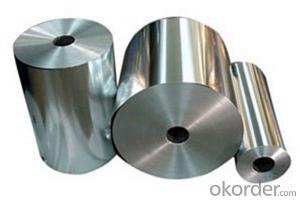Aluminum Foil Alloy 8011-O Temper For Waterproofing
- Loading Port:
- Shanghai
- Payment Terms:
- TT OR LC
- Min Order Qty:
- 5 m.t.
- Supply Capability:
- 30000 m.t./month
OKorder Service Pledge
OKorder Financial Service
You Might Also Like
ALUMINIUM HOUSEHOLD FOIL for roofing Alloy: 8011; Temper: O Surface finishing:; one side bright, one side matte
Specifications
1. advanced processing technology
2. accurate tolerance
3. fine craft and the best quality
ALUMINIUM HOUSEHOLD FOIL FOR ROOFING
Alloy: 8011
Temper: O
Surface finishing:; one side bright, one side matte
1.Specifications
Width range | 100~940 |
Thickness range | 0.009~0.025 |
Core materials | Aluminum or steel |
Inside diameters of core | 76.0, 152.0 |
Max. outside diameter of coil for Æ76 | 560 |
Max. outside diameter of coil for Æ, 152 | 700 |
Thickness Tolerance: +/-5%
Width Tolerance: +/-1 mm
Packaging requirements: seaworthy export standard packaging.
FAQ
1. How can I get some samples?
We are honored to offer you samples. New clients are expected to pay for the courier cost. The samples are free for you.
2 Do you have any certificates?
Our products passed inspection of SGS, FDA, and CE Quality is priority! Every worker keeps the QC from the very beginning to the very end, Quality control department especially responsible for quality checking in each process.
3 Can your factory print or emboss my logo on the goods?
Yes, we can print or emboss the logo on the goods or their packing box.
4 What information should I let you know if I want to get a quotation?
1) The specification of products (length x width x thickness);
2) The temper and alloy.
3) The final product you will use to be made
4 It will be better if you can show us the pictures or design sketch. Samples will be best for clarifying. If not, we will recommend relevant products with details for reference.We usually produce goods based on customers
Samples or based on customers’ picture, logo, sizes etc.
Our Services
1. Reasonable production arrangement to make delivery very fast;
2. We are able to provide leading tolerances, metallurgical assistance, quick and reliable delivery, samples for new products, etc.
3. We have the strong capability to meet your particular requirement for the products.
4.To guarantee the quality of the products we can meet most of the standards all over the world.
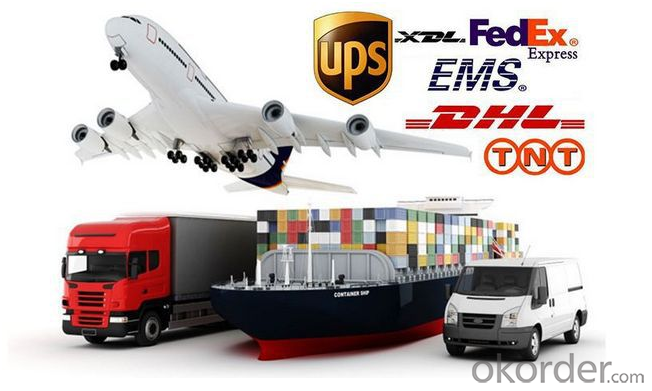
Photos
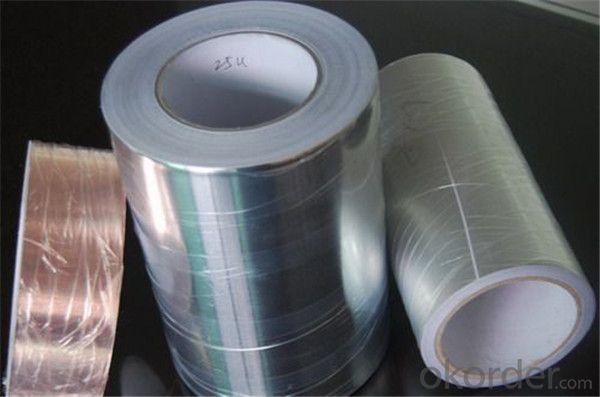

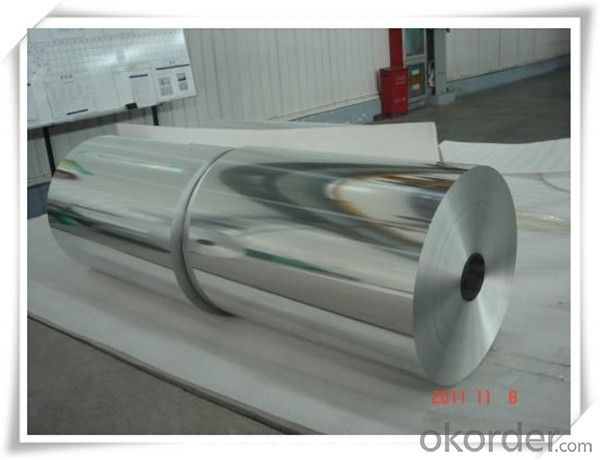
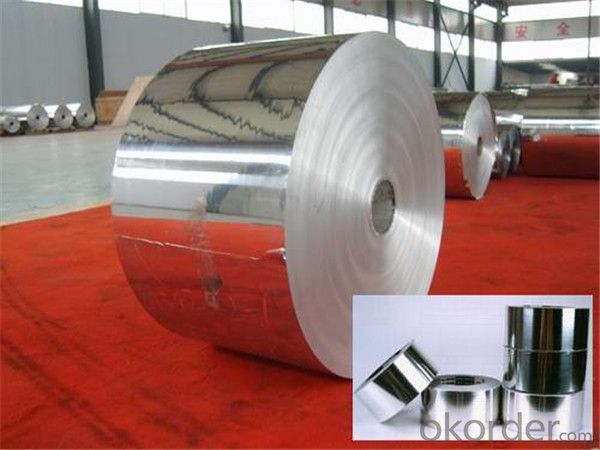
- Q:What are the different coil slitting methods for aluminum coils?
- Aluminum coils can be slit using various methods, each with its own advantages and suitability for different applications. Some commonly used methods for slitting aluminum coils are as follows: 1. Rotary Shear Slitting: This method involves the use of a rotating knife or shear blade to cut the aluminum coil into narrow strips. It is suitable for high-speed production lines and provides accurate and clean edges. 2. Looping Slit: In this method, the aluminum coil is looped and passed through rotating circular blades that cut it into desired widths, ensuring precise cuts. It is commonly used for thin aluminum coils and offers good accuracy and productivity. 3. Double Knife Slitting: Also known as duplex slitting, this method uses two circular knives positioned on top and bottom of the aluminum coil. The knives move in opposite directions, cutting the coil into multiple strips simultaneously. It is suitable for high-volume production and provides excellent accuracy and efficiency. 4. Razor Slitting: This method utilizes razor-sharp blades mounted on a rotating shaft to cut the aluminum coil. It is particularly suitable for thinner gauge coils and provides clean, burr-free edges. 5. Crush Slitting: Crush slitting involves compressing the aluminum coil between two rotating rolls with sharp edges. The pressure exerted by the rolls cuts the coil into desired widths. It is commonly used for thicker gauge coils and offers good productivity and edge quality. 6. Laser Slitting: Laser slitting uses a high-powered laser beam to cut the aluminum coil. This method offers exceptional precision and accuracy, making it ideal for intricate and complex cutting requirements. The choice of slitting method depends on factors such as coil thickness, desired strip widths, production volume, and edge quality requirements. Each method has its own advantages and limitations, so it is important to evaluate these factors in order to select the most appropriate slitting method for a specific application.
- Q:What are the common handling and storage practices for aluminum coils?
- The common handling and storage practices for aluminum coils involve several key steps to ensure their integrity and prevent damage or degradation. 1. Protection from physical damage: Aluminum coils should be handled and stored in a way that minimizes the risk of physical damage. This includes using proper lifting equipment to avoid dropping or mishandling the coils, as well as storing them in a secure location away from potential hazards such as heavy machinery or sharp objects. 2. Proper stacking and support: When stacking aluminum coils, it is important to ensure that they are supported evenly and not overloaded. Excessive weight or uneven support can cause deformation or even collapse of the coils. The use of appropriate stacking equipment and supports, such as pallets or racks, is recommended to maintain the integrity of the coils. 3. Protection from moisture and corrosion: Aluminum is susceptible to corrosion, especially when exposed to moisture. Therefore, it is crucial to store aluminum coils in a dry environment to prevent the formation of rust or other forms of corrosion. Coils should be stored in a covered area or inside a warehouse to protect them from rain, snow, or excessive humidity. Additionally, wrapping the coils in a protective material, such as plastic or moisture-resistant packaging, can provide an extra layer of defense against moisture intrusion. 4. Temperature control: Extreme temperatures can impact the quality and performance of aluminum coils. It is recommended to store them in a temperature-controlled environment to prevent any adverse effects. Excessive heat can cause the coils to expand or distort, while extreme cold can make them more brittle and prone to cracking. Maintaining a stable temperature within the recommended range ensures the longevity and usability of the aluminum coils. 5. Handling and storage guidelines: It is essential to follow any specific handling and storage guidelines provided by the manufacturer or supplier of the aluminum coils. These guidelines may include recommendations on stacking height, weight limits, and any necessary precautions to prevent damage or deformation. Adhering to these guidelines will help maintain the quality and usability of the coils. By implementing these common handling and storage practices for aluminum coils, you can ensure their protection, integrity, and optimal performance throughout their lifespan.
- Q:at what state is aluminum at room temperature?what are aluminums physical properties?what is aluminum obtained from?
- 1. Solid, liquid, or gas... I bet you can guess. 2. There's a mess of them in the right side info box of the wikipedia article:
- Q:Are aluminum coils suitable for marine environments?
- Aluminum coils are suitable for marine environments due to their excellent corrosion resistance properties. Aluminum has a natural oxide layer that forms on its surface, providing a protective barrier against saltwater corrosion. This makes aluminum coils highly resistant to rust and deterioration caused by exposure to marine conditions. Moreover, aluminum is lightweight, making it a preferred choice for marine applications where weight reduction is essential. Additionally, aluminum coils offer good thermal conductivity, which is beneficial for dissipating heat in marine cooling systems. Overall, aluminum coils are a reliable and durable choice for marine environments, ensuring long-lasting performance and minimal maintenance requirements.
- Q:What is the lifespan of aluminum coils?
- The lifespan of aluminum coils can vary depending on various factors such as the quality of the aluminum, the manufacturing process, the environmental conditions they are exposed to, and the maintenance provided. However, on average, aluminum coils can last anywhere from 15 to 30 years. With proper care and regular maintenance, including cleaning and inspection, aluminum coils can potentially have an extended lifespan. It is important to note that regular maintenance and servicing by professionals can help identify any issues early on, allowing for timely repairs or replacements, ultimately prolonging the lifespan of aluminum coils.
- Q:Who knows Xingtai aluminum shutter door how much is one square meter?
- Aluminum alloy rolling doors more than 10 specifications, prices are not the same, depending on the sample to know the price, the price range is probably between 100--800, a great difference between Oh!
- Q:Are aluminum coils compatible with other materials?
- Yes, aluminum coils are compatible with various materials, including steel, copper, and other non-ferrous metals. They can be used in conjunction with different materials to enhance their performance and provide various industrial applications.
- Q:The general roll also 5,6t appearance, specific to your own weigh, length, weight = / (width * thickness * density)
- Oh, landlord, this question is a little interestingIf it is the embryo of the aluminum plant, the aluminum roll is usually 5-6 tons a rollFor a while, in the merchant or the direct manufacturer, it is necessary to see how large the material rack is in the factory. It is usually 1.5-2 tons, and there are also three tons.Yes, please!
- Q:How do aluminum coils contribute to architectural design flexibility?
- Architectural design flexibility is greatly enhanced by the unique properties and versatility of aluminum coils. Firstly, their lightweight nature simplifies handling and installation, in contrast to materials like steel or concrete. This attribute grants architects the freedom to explore more imaginative and innovative designs, unburdened by weight constraints. It also facilitates the construction of large and intricate structures, providing architects with greater design freedom. Secondly, aluminum coils offer an extensive array of surface finishes and colors. They can be painted, anodized, or coated with various materials, enabling architects to achieve desired aesthetic effects and harmonize the building's appearance with its surroundings or intended architectural style. This broad range of finishes allows architects to experiment with diverse visual effects, textures, and patterns, thereby enhancing overall design flexibility. Furthermore, aluminum coils possess exceptional corrosion resistance properties. This durability ensures that architectural elements made from aluminum coils can withstand harsh weather conditions, such as rain, snow, or UV radiation, without deteriorating over time. The extended lifespan and minimal maintenance requirements of aluminum coils make them an appealing choice for architects seeking sustainable and long-lasting design solutions. Moreover, aluminum coils can be easily shaped, bent, or formed into an assortment of profiles and dimensions. This malleability empowers architects to create custom architectural elements that meet specific design requirements, such as curved facades, intricate detailing, or irregular shapes. The ability to mold aluminum coils according to the architect's vision enables the realization of distinctive and unique designs that stand out in the architectural landscape. Lastly, aluminum coils are recyclable and environmentally friendly. By incorporating aluminum into architectural design, architects align themselves with sustainable practices, as aluminum can be recycled repeatedly without losing its properties. This aspect appeals to architects and clients who prioritize eco-friendly design solutions and seek to minimize their carbon footprint. In conclusion, aluminum coils significantly contribute to architectural design flexibility by offering lightweight construction, a wide range of surface finishes, excellent corrosion resistance, malleability, and recyclability. These characteristics empower architects to push the boundaries of design, create visually stunning structures, and deliver sustainable and enduring architectural solutions.
1. Manufacturer Overview |
|
|---|---|
| Location | |
| Year Established | |
| Annual Output Value | |
| Main Markets | |
| Company Certifications | |
2. Manufacturer Certificates |
|
|---|---|
| a) Certification Name | |
| Range | |
| Reference | |
| Validity Period | |
3. Manufacturer Capability |
|
|---|---|
| a)Trade Capacity | |
| Nearest Port | |
| Export Percentage | |
| No.of Employees in Trade Department | |
| Language Spoken: | |
| b)Factory Information | |
| Factory Size: | |
| No. of Production Lines | |
| Contract Manufacturing | |
| Product Price Range | |
Send your message to us
Aluminum Foil Alloy 8011-O Temper For Waterproofing
- Loading Port:
- Shanghai
- Payment Terms:
- TT OR LC
- Min Order Qty:
- 5 m.t.
- Supply Capability:
- 30000 m.t./month
OKorder Service Pledge
OKorder Financial Service
Similar products
New products
Hot products
Related keywords

